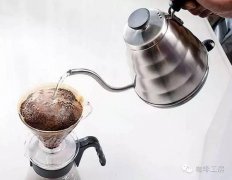Deep coffee expertise | pre-soaking: when can and when not [Scott

Not long ago, Scott Rao posted a new article on his blog. He believes that it is wrong for many people to take steaming when brewing coffee powder. In the past, steaming was not a necessary step before cooking, but now almost all cooking takes steaming as a preprocess. Scott Rao even thinks that steaming can sometimes be counterproductive.
Why do you want to Why prewet?
Steaming brings some benefits to cooking: it can help reduce extraction bias, improve extraction efficiency, and extraction uniformity. For espresso extraction, "steaming" (pre-soaking) can also reduce the migration of coffee particles, making the extraction effect twice the result with half the effort.
(translator's note: Scott Rao mentioned "the problem of coffee particle migration" many times in his books and speeches. Combined with this article, he believes that beans will produce very fine powder after grinding. Through steaming, the ultra-fine powder can expand after absorbing water, resulting in water resistance and positive effect. After a simple experiment, the translator compares the normally ground coffee powder with the coffee powder sifted with very fine powder, and the flavor of the coffee powder with very fine powder is better, and there are more levels of flavor. However, the experiment is simple and rough, and it can not be asserted that it is the positive effect of reducing the migration of coffee particles after the water-absorbing expansion of ultra-fine powder. )
Steaming and deflecting (Prewetting and channeling)
If a barista skips steaming and just injects water into the coffee powder in the V60 filter cup, it will make the extraction uneven and some of the coffee powder will not be wet. In this way, once there is no wetting in some areas, the water will give priority to the areas that are already wet, while the dry areas will reject the invasion of water. However, in the end, all coffee powder will be wet by water, but this is passive wetting, which will make the extraction uneven and affect the taste.
Uniformity of pre-immersion and extraction (Prewetting and extraction uniformity)
In a way, there are two types of coffee powder: one is particles that no longer have complete cellular tissue, and the other is particles with one or more cellular tissues. When water extracts particles without intact cellular tissue, it is easy and effective. On the other hand, coffee particles with one or more cell tissues must enter and dissolve these extractable components through cell pores, which is very passive and difficult to get good quality extraction.
Thus it can be seen that the most important role of steaming is to provide sufficient time for the water to begin to spread to the whole coffee powder tissue.
Pre-immersion (Espresso preinfusion) of Espresso
The pre-soaking of Espresso is similar to the steaming of hand-brewed coffee. Ideally, the pre-immersion of Espresso is to soak the coffee pressed powder at a low speed (2-3ml/ seconds) under the pressure of 0bars, which does not continuously increase the pressure. In this way, before the high pressure comes, the hot water soaks the extractable substances in pressed powder, making the subsequent high-pressure extraction uniform. At the same time, it also reduces the migration of coffee particles.
Steaming and soaking (Prewetting and immersion brewing)

I believe that steaming in immersion cooking has no practical meaning and may even be counterproductive. Now let's do an experiment in which we prepare two portions of pressure, both of which are boiled at a rate of 1:17, with 95 degrees Celsius water, one steaming for 45 seconds and the other none at all. It took a total of 4 minutes and 30 seconds.
As a result, in the case of steaming, the coffee powder is partly brewed with high TDS and partly brewed with low TDS, which is not as uniform as water injection. Therefore, as soon as the steamed taste enters the mouth, there is an unpleasant feeling, and the extraction is uneven.
Many years ago, I found that water injection is better, because all coffee powder is brewed at the same water temperature and TDS, 1:17 gouache than all fusion can expose the whole coffee particles to a low TDS, but when pre-soaked at 2:1, there is not enough clean water to touch coffee particles.

But
I guess some people will retort, "my soaking steaming would be better." Or "some baristas won the championship by steaming in the brewing contest." I also agree that steaming will bring good results in immersion cooking. But when it comes to the method of extracting coffee, the most important question is not "which method can make the best coffee", but "which method can make the most stable coffee".
The most essential principles when making coffee are "achieving the most uniform extraction" and "ensuring the desired extraction yield". According to this standard, pre-soaking is beneficial to filter extraction, but immersion is not. If you want to try the difference between steaming and steaming, please take a pen and write it down, but the best experimental results should be repeated tests with different grindings and different water temperatures. A fair experimental data and extraction assessment should be well organized. Then, as always, don't be embarrassed to retort. I don't have the answers to all the questions, and I'd like to hear everyone's experience and opinions.
Translation | Charlie
Edit | Charlie
Important Notice :
前街咖啡 FrontStreet Coffee has moved to new addredd:
FrontStreet Coffee Address: 315,Donghua East Road,GuangZhou
Tel:020 38364473
- Prev

Why do more and more people like making coffee by hand?
When you walk into the cafe, the barista kindly asks you if you want to drink Italian or hand flush? Looking up at the menu, in addition to the familiar latte, cappuccino and so on, I found that there was an extra column of hand-made coffee next to it. What is Italian style and what is hand punch? What are the utensils of different shapes on the bar for? Kenya, Guatemala, Ethiopia Yega
- Next

[technical post] stop saying that the coffee is not good! The correction method when the taste of hand-made coffee is wrong.
You may find out more often why the coffee in the cafe is so good, but the coffee made by yourself is not good enough! At this time, you always think, why do you still do this when you follow the steps step by step? There are many reasons: water quality, grinding, manipulation, and water temperature are all variable. First, control the flow of water and learn about the secret of the construction of hand pots. There are all kinds of hand pots on the market.
Related
- Beginners will see the "Coffee pull flower" guide!
- What is the difference between ice blog purified milk and ordinary milk coffee?
- Why is the Philippines the largest producer of crops in Liberia?
- For coffee extraction, should the fine powder be retained?
- How does extracted espresso fill pressed powder? How much strength does it take to press the powder?
- How to make jasmine cold extract coffee? Is the jasmine + latte good?
- Will this little toy really make the coffee taste better? How does Lily Drip affect coffee extraction?
- Will the action of slapping the filter cup also affect coffee extraction?
- What's the difference between powder-to-water ratio and powder-to-liquid ratio?
- What is the Ethiopian local species? What does it have to do with Heirloom native species?

